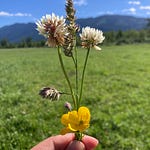It’s an overcast day, which is another way of saying an average day in Seattle, and today I am thinking about trees. I’m reflecting on what I’ve learned about them, and what we can learn from them, and how we interact with them. It ended up being a fairly tree-filled weekend, so today’s post is a slice of life - in particular, a study of the past few days - told through my interactions with trees. Read on below.
Friday: One-Third Aged
If I’m anything like the matriarchs on my mom’s side of the family, I’ll live well into my 90s, which means I’m only about a third of the way through my life. I thought about that on Friday, during a lighthearted conversation with some of my students at the university. Somehow it came up in conversation that the following day, I would be taking a two-hour native tree tour. I half-jokingly implored them to prepare for middle age, when they would one day wake up and suddenly be extremely into trees, and perhaps even birds. They all laughed, and I did too, realizing somewhere in the middle of my chuckle that I might be - what would you call this - one-third aged?
Saturday: Tree Tour
Twice, it sprinkled half-heartedly on us, but for the rest of the 2-hour block, the weather held up, and our group of about 30 budding dendrologists clustered eagerly around tree after tree, humming with wonder at both their subtle and extreme differences, and their innate intelligence. My favorite was the Pacific madrone (sometimes referred to locally as a Madrona). It requires an acidic soil, and is part of the same family (Ericaceae) as salal and huckleberry plants. Preferring to conserve its energy, it continuously grows and sheds its bark to prevent other plant life from clinging to it. The wood under its bark is beautiful, smooth, artistic even - and it’s no surprise that many local woodworkers choose this as their medium. The wood is light and waxy, with tones of yellow and green. We learned that green wood means the tree is photosynthesizing through its trunk and branches, in addition to its leaves. What an incredible adaptation. I’m not sure how many times I said “wow” out loud, but if I had a dollar for each time, I could buy a pretty good snack. (Not a meal, though, because if you’ve ever been to Seattle, you know food is expensive here).
My favorite thing about the Pacific madrone is its delicate white flowers, which grow in clusters and both smell and taste like the finest honey. I would describe them as floral and fragrant, with a subtle honey perfume. One of the friends who joined me described them as “yummy stinky,” which I think is better.
This same friend also noticed an odd, white, looping pattern on some of the madrone’s hearty leaves. These are the tracks of a weevil, who ate a circuitous path through a few leaves. I grew angry on the tree’s behalf when I learned this, and also a little itchy. Maybe I just don’t like weevils (I also do not recommend googling them, which I did to check the spelling).
Two hours just about flew by (the 90-minute mark was when I started getting hungry and considering the impending expiration on my parking meter). We visited 6 or 7 trees total, learning about identification and evolutionary adaptations, like fire-heartiness, the reasons for needles versus leaves, and branch height. I was floored to learn that trees will self-shed their lowest branches, investing instead in higher-ups, getting the most photosynthetic bang for their buck.
In addition to all of this, I was also interested in the study of the people - the tree-curious folks who chose to spend their Saturday afternoon feeling fir needles between their fingers, learning to distinguish them from the spikier spruce. A British man in a blue terrycloth hoodie had been on the tour before and was especially interested in the maple syrup-ability of the Big leaf maple we encountered. A college-aged woman in knee-high socks asked questions at every stop. An elderly gentleman leaned forward onto his trekking poles. Our tour guide sported a Yosemite hat laden with national park pins. He wore a “Find Me in the Forest” shirt and a wide smile. It was clear that he loved his job, spouting off facts and answering questions enthusiastically, referencing books about trees he had read or was excited to read. It made me happy, knowing that here was a person who had found a job he loved so much. I wanted that for everyone else in our little semi-circle. Maybe that’s the career coach in me.
Sunday: Plant Mom
According to the CliftonStrengths assessment, one of my top 10 talent themes is adaptability. I’ve learned that I’m pretty good at flying by the seat of my pants, improvising in the moment, and quickly responding to emerging needs. I also have a tendency to overuse this strength, which means that I sometimes let myself procrastinate because I know I can pull things together last minute. (And in my defense, I am a fairly busy lady). So here I am on a Sunday afternoon, composing the post that I intend to publish later today.
Before that, however, I will mosey down to the plant nursery nearby. I will whisper to the plants and rub their fragrant leaves between my fingers, hoping to smell like thyme or lavender or mint for more than a few fleeting moments. Maybe I’ll buy something that I will tend with care, and maybe it will die. I’ll let the wind tousle my hair on the walk home.













Share this post